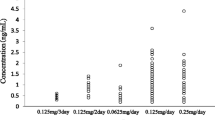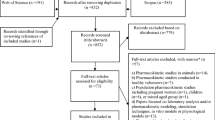Abstract
Digoxin-induced bradycardia in dogs was used to evaluate several pharmacodynamic models. Digoxin plasma concentrations and response were monitored in beagle dogs administered either 0.05 or 0.025 mg/kg of digoxin iv as an infusion over 5 min. The models investigated were the linking model, the linear model, the effect compartment model, and the inhibitory model. Regression procedures for investigating the effect compartment model were conducted with Emax (the maximal response, where response was the percentage decrease in heart rate) as a variable with an upper bound of 100%, with a constant value of 100%, or alternately with a constant value equal to the maximal observed reponse. Based on statistical criteria the effect model using Emax, as a variable was found to be the best model for describing digoxin-induced bradycardia. For the effect compartment model, CPss(50) (concentration at steady state that will produce 50% of the maximal response) ranged from 3.8–9.8 ng/ml; δ (exponent describing the steepness of the concentration-response relationship) ranged from 0.6–7.1. The implications of these models in understanding concentration-effect relationships are discussed.
Similar content being viewed by others
References
B. Whiting, N. H. G. Holford, and L. B. Sheiner. Quantitative analysis of the disopyramide concentration-effect relationship.Br. J. Clin. Pharmacol. 9:67–75 (1980).
N. H. G. Holford, P. E. Coates, T. W. Guentert, S. Riegelman, and L. B. Sheiner. The effect of quinidine and its metabolites on the electrocardiogram and systolic time intervals: Concentration-effect relationships.Br. J. Clin. Pharmacol. 11:87–195 (1981).
M. Eichelbaum, P. Birkel, E. Grube, U. Gutgemann, and A. Somogyi. Effects of verapamil on P-R intervals in relation to verapamil plasma levels following single iv and oral administration and during chronic treatment.Klin. Wochschr. 58:919–925 (1980).
L. R. Whitfield and G. Levy. Relationship between concentration and anticoagulant effect of heparin in plasma of normal subjects: Magnitude and predictability of interindividual differences.Clin. Pharmacol. Ther. 28:509–516 (1980).
R. A. O'Reilly. Studies on the optical enantiomorphs of warfarin in man.Clin. Pharmacol. Ther. 16:348–354 (1974).
P. A. Mitenko and R. I. Ogilvie. Rational intravenous doses of theophylline.New Engl. J. med. 289:600–603 (1973).
T. Ishizaki, H. Hirayama, K. Tawara, H. Nayaka, M. Sato, and K. Sato. Pharmacokinetics and pharmacodynamics in young normal and elderly hypertensive subjects: A study using sotalol as a model drug.J. Pharmacol. Exp. Ther. 212:173–181 (1980).
B. N. Singh, F. M. Williams, R. M. Whitlock, J. Collett, and C. Chew. Plasma timolol levels and systolic time intervals.Clin. Pharmacol. Ther. 27:159–166 (1980).
D. R. Stanski, J. Ham, R. D. Miller, and L. B. Sheiner. Pharmacokinetics and pharmacodynamics of d-tubocurarine during nitrous oxide-narcotic and halothane anesthesia in man.Anesthesiology 51:235–241 (1979).
D. R. Stanski, R. J. Hudson, T. D. Homer, L. J. Saidman, and E. Meathe. Pharmacodynamic modeling of thiopental anesthesia.J. Pharmacokin. Biopharm. 12:223–240 (1984).
R. H. Reuning, R. A. Sams, and R. E. Notari. Role of pharmacokinetics in drug dosage adjustment. Pharmacologie effect kinetics and apparent volume of distribution of digoxin.J. Clin. Pharmacol 4:127–141 (1973).
W. G. Kramer, A. J. Kolibash, R. P. Lewis, M. S. Bathala, J. A. Visconti, and R. H. Reuning. Pharmacokinetics of digoxin: Relationship between intensity and predicted compartmental drug levels in man.J. Pharmacokin. Biopharm. 7:47–61 (1979).
E. R. Garrett. The pharmacokinetic bases of biological response quantification in toxicology pharmacology and pharmacodynamics.Progr. Drug. Res. 21:105–230 (1977).
N. H. G. Holford and L. B. Sheiner. Pharmacokinetic and pharmacodynamic modeling in vivo.CRC Crit. Rev. Bioeng. 5:273–322 (1981).
S. J. Vetticaden, W. H. Barr, and L. A. Beightol. An improved method for assaying digoxin in serum using HPLC-RIA.J. Chromatog. 383:187–193 (1986).
A. W. Kelman and B. Whiting. Modeling of drug response in individual subjects.J. Pharmacokin. Biopharm. 8:115–130 (1980).
L. B. Sheiner, D. R. Stanski, S. Vozeh, R. D. Miller, and J. Ham. Simultaneous modeling of pharmacokinetics and pharmacodynamics: Application to d-tubocurarine.Clin. Pharmacol. Ther. 25:358–371 (1979).
H. G. Boxenbaum, S. Riegelman, and R. M. Elashoff. Statistical estimations in pharmacokinetics.J. Pharmacokin. Biopharm. 2:123–147 (1974).
H. Akaike. A new look at the statistical model identification.IEEE Tr. Atuomat. Contr. 19:716–723 (1973).
H. Akaike. An information criterion (AIC).Math. Sci. 14:5–9 (1976).
K. Yamaoka, T. Nakagawa, and T. Uno. Application of Akaike's information criterion (AIC) in the evaluation of linear pharmacokinetic equationsJ. Pharmacokin. Biopharm. 6:165–176 (1978).
Author information
Authors and Affiliations
Rights and permissions
About this article
Cite this article
Vetticaden, S.J., Barr, W.H. & Allison, T.B. Pharmacodynamic modeling of digoxin-induced bradycardia. Journal of Pharmacokinetics and Biopharmaceutics 17, 89–107 (1989). https://doi.org/10.1007/BF01059089
Received:
Revised:
Published:
Issue Date:
DOI: https://doi.org/10.1007/BF01059089




